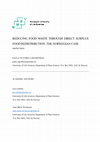Papers by Paula Capodistrias

Socio-economic Planning Sciences, Aug 1, 2022
This paper examines the impact of the COVID-19 crisis on the functioning of European food banks a... more This paper examines the impact of the COVID-19 crisis on the functioning of European food banks and how resilient European food banks were in coping with the pandemic in 2020. We apply a multiple case study to assess how the first year of the pandemic affected European food banks’ operations and the amount of redistributed food. We further investigate innovation practices that have been developed to cope with the new situation, hoping to draw lessons for imminent future waves of the pandemic and other social crises. Our study finds that, compared to 2019, in 2020 food banks were able to redistribute a significantly higher amount of food despite numerous social restrictions and other challenges associated with the pandemic. To explain this, we delve into the organizational innovations implemented by the studied food banks and find that the introduction of new strategies and new internal structures, as well as the establishment of new types of external network relations with other firms and/or public organizations, proved to be particularly important, enabling food banks to respond quickly and effectively to the new emergency. The study thus highlights the role of food banks in food redistribution and food waste reduction in times of crisis. © 2021

36, Aug 7, 2015
Food waste is a global problem with significant economic and environmental consequences. Food was... more Food waste is a global problem with significant economic and environmental consequences. Food waste management approaches include production of biogas, animal feed and compost and surplus food redistribution. From a sustainability point of view, surplus food redistribution is the most favorable approach. Surplus food redistribution can be either direct (between suppliers of surplus food and charity food services) or indirect (Through Food banks). This paper is a case study on direct surplus food redistribution in ten cities in Norway. The study explores the logistics, embedded social relationships and volume of surplus food redistributed through charity food services. The results show that the logistics of direct redistribution in the cities included in this study are complex, efficient and formal. Direct surplus food redistribution in Norway is heavily dependent on the workforce of volunteers and personal relationships among the participating actors. Every day 3500 meals are made with ingredients from direct redistribution in the ten cities included in the study. In conclusion, the study suggest that current surplus food redistribution in the cities included in this study make a significant contribution to food waste reduction and surplus food redistribution should be considered as a strategy to reduce food waste.M-A

Food waste is a global problem with significant economic and environmental consequences. Food was... more Food waste is a global problem with significant economic and environmental consequences. Food waste management approaches include production of biogas, animal feed and compost and surplus food redistribution. From a sustainability point of view, surplus food redistribution is the most favorable approach. Surplus food redistribution can be either direct (between suppliers of surplus food and charity food services) or indirect (Through Food banks). This paper is a case study on direct surplus food redistribution in ten cities in Norway. The study explores the logistics, embedded social relationships and volume of surplus food redistributed through charity food services. The results show that the logistics of direct redistribution in the cities included in this study are complex, efficient and formal. Direct surplus food redistribution in Norway is heavily dependent on the workforce of volunteers and personal relationships among the participating actors. Every day 3500 meals are made with ingredients from direct redistribution in the ten cities included in the study. In conclusion, the study suggest that current surplus food redistribution in the cities included in this study make a significant contribution to food waste reduction and surplus food redistribution should be considered as a strategy to reduce food waste.

Socio-Economic Planning Sciences
This paper examines the impact of the COVID-19 crisis on the functioning of European food banks a... more This paper examines the impact of the COVID-19 crisis on the functioning of European food banks and how resilient European food banks were in coping with the pandemic in 2020. We apply a multiple case study to assess how the first year of the pandemic affected European food banks’ operations and the amount of redistributed food. We further investigate innovation practices that have been developed to cope with the new situation, hoping to draw lessons for imminent future waves of the pandemic and other social crises. Our study finds that, compared to 2019, in 2020 food banks were able to redistribute a significantly higher amount of food despite numerous social restrictions and other challenges associated with the pandemic. To explain this, we delve into the organizational innovations implemented by the studied food banks and find that the introduction of new strategies and new internal structures, as well as the establishment of new types of external network relations with other firms and/or public organizations, proved to be particularly important, enabling food banks to respond quickly and effectively to the new emergency. The study thus highlights the role of food banks in food redistribution and food waste reduction in times of crisis. © 2021

In the last few years, Norwegian supermarkets have set in place different strategies to reduce fo... more In the last few years, Norwegian supermarkets have set in place different strategies to reduce food
waste. These include more efficient internal practices but also the promotion of food with short
shelf life at a reduced price, and the redistribution of surplus food to charity. Unfortunately, our
research shows that while 98 % of Norwegian supermarkets have a designated area of the store to
promote food with short shelf life for up to a 50 % discount, only 48 % of the supermarkets donates
its surplus to charity. The most active supermarkets donating surplus food to charity are KIWI (90
% of the stores) and REMA 1000 (80 % of the stores), while less than 20 % of the smaller
supermarkets like JOKER or MATKROKEN donate their surplus to charity. When looking at the
situation nationally, we found that supermarkets in Kristiansand and Tromsø are among the ones
donating the most, while in Oslo only 20 % of the supermarkets are currently donating its surplus
to charity. Although most store managers report that the reason they don’t donate surplus food is
because they don’t have anything left at the end of the day, our research found evidence that food
waste containers outside supermarkets still have a lot of edible food in them. The results of this
study show that more transparency and collaboration between supermarkets and charity
organizations is needed. While a voluntary approach has shown some success, inconsistencies
between and within supermarket chains might require a legislative approach to support and
encourage a more successful approach towards food waste reduction in the supply value chain.

Food waste is a global problem with significant economic and environmental consequences. Food was... more Food waste is a global problem with significant economic and environmental consequences. Food waste management approaches include production of biogas, animal feed and compost and surplus food redistribution. From a sustainability point of view, surplus food redistribution is the most favorable approach. Surplus food redistribution can be either direct (between suppliers of surplus food and charity food services) or indirect (Through Food banks). This paper is a case study on direct surplus food redistribution in ten cities in Norway. The study explores the logistics, embedded social relationships and volume of surplus food redistributed through charity food services. The results show that the logistics of direct redistribution in the cities included in this study are complex, efficient and formal. Direct surplus food redistribution in Norway is heavily dependent on the workforce of volunteers and personal relationships among the participating actors. Every day 3500 meals are made with ingredients from direct redistribution in the ten cities included in the study. In conclusion, the study suggest that current surplus food redistribution in the cities included in this study make a significant contribution to food waste reduction and surplus food redistribution should be considered as a strategy to reduce food waste.











Uploads
Papers by Paula Capodistrias
waste. These include more efficient internal practices but also the promotion of food with short
shelf life at a reduced price, and the redistribution of surplus food to charity. Unfortunately, our
research shows that while 98 % of Norwegian supermarkets have a designated area of the store to
promote food with short shelf life for up to a 50 % discount, only 48 % of the supermarkets donates
its surplus to charity. The most active supermarkets donating surplus food to charity are KIWI (90
% of the stores) and REMA 1000 (80 % of the stores), while less than 20 % of the smaller
supermarkets like JOKER or MATKROKEN donate their surplus to charity. When looking at the
situation nationally, we found that supermarkets in Kristiansand and Tromsø are among the ones
donating the most, while in Oslo only 20 % of the supermarkets are currently donating its surplus
to charity. Although most store managers report that the reason they don’t donate surplus food is
because they don’t have anything left at the end of the day, our research found evidence that food
waste containers outside supermarkets still have a lot of edible food in them. The results of this
study show that more transparency and collaboration between supermarkets and charity
organizations is needed. While a voluntary approach has shown some success, inconsistencies
between and within supermarket chains might require a legislative approach to support and
encourage a more successful approach towards food waste reduction in the supply value chain.
waste. These include more efficient internal practices but also the promotion of food with short
shelf life at a reduced price, and the redistribution of surplus food to charity. Unfortunately, our
research shows that while 98 % of Norwegian supermarkets have a designated area of the store to
promote food with short shelf life for up to a 50 % discount, only 48 % of the supermarkets donates
its surplus to charity. The most active supermarkets donating surplus food to charity are KIWI (90
% of the stores) and REMA 1000 (80 % of the stores), while less than 20 % of the smaller
supermarkets like JOKER or MATKROKEN donate their surplus to charity. When looking at the
situation nationally, we found that supermarkets in Kristiansand and Tromsø are among the ones
donating the most, while in Oslo only 20 % of the supermarkets are currently donating its surplus
to charity. Although most store managers report that the reason they don’t donate surplus food is
because they don’t have anything left at the end of the day, our research found evidence that food
waste containers outside supermarkets still have a lot of edible food in them. The results of this
study show that more transparency and collaboration between supermarkets and charity
organizations is needed. While a voluntary approach has shown some success, inconsistencies
between and within supermarket chains might require a legislative approach to support and
encourage a more successful approach towards food waste reduction in the supply value chain.